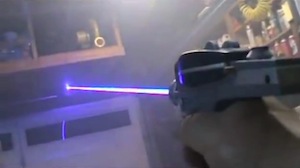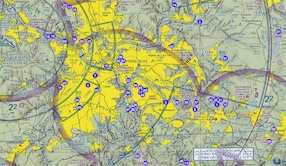Home
A comprehensive resource for safe and responsible laser use
US: FDA now recommending aircraft/vehicle caution label
“CDRH recommends (but does not require) labeling on your product that cautions the purchaser with following or similar language: “CAUTION - LASER LIGHT IS BRIGHT AND BLINDING - DO NOT SHINE AT AIRCRAFT OR VEHICLES AT ANY DISTANCE”.
While FDA can require the familiar labels warning against laser eye and skin hazards, FDA does not have statutory authority to require labels for non-health hazards such as laser distraction or temporary flash blinding. Thus, the agency is only able to recommend -- but not require -- the new aircraft/vehicle caution label.
News of the action came in a December 7 2012 FDA email sent to parties including LaserPointerSafety.com. According to CDRH’s Daniel Hewett, the action applies to all “SLA products.” FDA/CDRH considers that laser pointers and handheld lasers are a subset of such Surveying, Leveling and Alignment laser products. SLA lasers are one of the three laser product uses which FDA can regulate under 21 CFR 1040.10 and 1040.11; the other two are medical and demonstration (education/light show) laser product uses.
From a Dec. 7 2012 FDA email. Thanks to Daniel Hewett for bringing this to our attention.
US: UPDATED - Maryland bill reintroduced to raise fines on pointer/aircraft misuse
Click to read more...
US: Myrtle Beach area proposed ban on laser pointer sales
The ordinance would make it illegal to sell lasers over 1 milliwatt, or to sell any green laser to persons under 18. Adults misusing lasers would be charged with assault and battery, with a fine of up to $500, up to 30 days in jail, and being held liable for any damage or personal injury. Minors misusing lasers would be prosecuted in Family Court, plus parents would be held responsible and could be fined or jailed.
In addition, a warning would be required with the sale of every laser pointer.
Under county procedure, it takes three “readings” at council meetings to pass an ordinance. Based on the council’s schedule, the earliest it could be passed would be in January 2013.
From CarolinaLive. This is part of continuing stories at LaserPointerSafety.com about ongoing problems at Myrtle Beach and North Myrtle Beach.
New Zealand: UPDATED - Laser pointer bill introduced by MP
The bill does not appear to have any laser power limitation; thus, even possession of a laser less than 1 milliwatts (legal in most countries) would be banned under the proposed legislation.
The key text is as follows:
“13B Possession of hand-held lasers
“(1) Every person is liable to imprisonment for a term not exceeding 3 months or a fine not exceeding $2,000 who, in any public place, without reasonable excuse, has any hand-held laser in his or her possession.
“(2) Any constable may without warrant seize and detain any hand- held laser which there is reasonable ground to suppose is in contravention of subsection (1) of this section.
“(3) On convicting any person of an offence against subsection (1) of this section, the Court may order that the hand-held laser be forfeited to the Crown.
“(4) In this section hand-held laser means any hand-held device, designed or adapted to emit a laser beam.”
From MSNNZ News and CamCalder.co.nz. The full text of the bill, including an introductory explanatory section, can be downloaded as a PDF file.
UPDATED September 25 2013: The bill unanimously passed its first reading. LaserPointerSafety.com has an article on this, plus a transcript of the debate.
New Zealand: Proposed options for controlling laser pointers, after 100 incidents in 2011
New Zealand does not have laws restricting the import, use and sale of high-powered laser pointers.
The deadline for commenting is December 14 2012 at 5 pm. The New Zealand laser pointer consultation document can be downloaded from here.
Feedback from the consultation will help the government determine its final proposals.
From Voxy.co.nz
New Zealand: Pilots want laser pointers prohibited
The pilots expressed concern following the September 2012 conviction of a teenager who aimed a green pointer at three commercial aircraft and a police helicopter in January 2012.
The NZALPA president said “It has reached a stage where any member of the public can purchase a commercial grade laser and do what they please with it.”
From Radio New Zealand and Voxy
US: New York area officials ask for public's help
A pilot from the Air Line Pilots Association told of his experiences when hit by laser light, and said that “Laser illumination can cause temporary blindness and even permanently damage a pilot’s eyes, potentially leading to an aircraft accident…Individuals must understand the danger and their responsibility to report anyone who misuses lasers.”
The Port Authority of New York and New Jersey is sending officers to schools near airports, to explain the hazards of lasers to children, and to warn them against aiming at aircraft.
An FBI agent said that the bureau is worried about adults and deliberate attacks by terrorists. Fines can range up to $11,000, said an FAA representative. a Coast Guard pilot said that rules requiring helicopters to break off rescues if they are directly lasered, adds to the risk of those the Coast Guard is trying to rescue.
The various law enforcement officials said they were asking the public to call 911 or local authorities if they see misuse, because laser incidents are so frequent and it is rare to apprehend the perpetrators.
A radio station public service announcement has been produced and aired by radio station NJ 101.5. It warns listeners not to aim at aircraft.
From NBC New York and New Jersey 101.5
Catching up: Statistics, laws & other news August/Sept 2012
US: No new laser ordinance yet in Horry County, South Carolina. Due to increasing incidents involving Coast Guard and other aircraft, and increased harassment of citizens, the county considered a new ordinance but tabled it for more study. This area includes Myrtle Beach and North Myrtle Beach. From Myrtle Beach Online, September 4.
US: Horry County, South Carolina, to consider a ban on laser pointers above 1 milliwatt. The article gives details on the proposed ordinance to curb widespread laser misuse. Billboards also have appeared in the county, warning about laser misuse. From Myrtle Beach Online, September 1.

A billboard in the Myrtle Beach area
UK: Lasers posing a “real threat” were seized from a shop in Crawley, West Sussex. One laser tested was “five times what is considered safe for eyes” and could cause a “serious temporary distortion of vision” or if aimed at drivers or pilots, “could have serious and potentially fatal consequences.” From West Sussex Today, August 12 and This Is Sussex, August 15.
US: Laser hits on Coast Guard aircraft from Air Station Savannah have halted air searches, according to a Coast Guard blog post. Incidents and statistics are given in the post, written by Lt. Stephanie Young. From the Coast Guard Compass, August 14.
US: The Horry (S.C.) County Council heard a presentation by the Coast Guard on the recent laser hits to their rescue helicopters, and on the hazards of lasers to aviation. They were told that a direct hit immediately grounds the helicopter. From CarolinaLive, August 14.
US: Problems with harassment and aviation interference, in the Myrtle Beach and Horry County area, are detailed in a story from the Post and Courier, August 12.
Note: Some of the above stories are part of continuing coverage at LaserPointerSafety.com about ongoing problems at Myrtle Beach and North Myrtle Beach.
US: Newsday editorial calls for warnings, enforcements to reduce laser attacks
The paper, ranked 13th in the country with a circulation of 393,000 weekday subscribers, said “It’s a serious offense that should be firmly punished…. Heavy fines, and in some cases, jail time, would send a powerful message that it’s a life-threatening crime.”
The editorial was the result of incidents in the Long Island area in the past month. It was titled “Enforce anti-laser laws with laser-like force.”
From Newsday. Subscriber information from USA Today.
UK: Leeds Bradford Airport has 3 laser incidents per week
From the Yorkshire Evening Post
US: Ocean City MD having increasing laser harassment problems
On July 29 2012, the Police Department issued a press release detailing the law’s requirements and penalties. To see the release, click the “Read More” link below.
Via WGMD. See also a related story from DelMarVaNow.com.
Click to read more...
US: Sen. Schumer asks FDA to overhaul laser regulations
From the Associated Press via the Wall Street Journal. To read the text of Schumer’s letter to the FDA, and his press release, click the Read More link below.
Click to read more...
US: Myrtle Beach considering further laser regs; current ones aren't working
A meeting was held with local officials, including representatives from Myrtle Beach, the Coast Guard, the Chamber of Commerce and the Horry County Council, to discuss options. The director of airports said that existing ordinances are not enough. He wants “a way to look at regulating the size and power of lasers that are sold in our community and region.”
Rather than local cities passing ordinances, one approach is for county-wide regulations. The topic will continue to be discussed at future county council meetings.
From CarolinaLive. This is part of continuing stories at LaserPointerSafety.com about ongoing problems at Myrtle Beach and North Myrtle Beach.
US: 198 calls to police about lasers in 3 months; Coast Guard "cracking down" in Myrtle Beach
The local Coast Guard echoes the concerns. Twice in two weeks, search and rescue missions were ended prematurely because of lasers being aimed at helicopters. (See a report here.) Under Coast Guard regulations, after laser exposure the aircraft is grounded and the pilots are medically evaluated before being allowed to fly again.
The Coast Guard issued a letter asking the public to stop aiming at aircraft, and saying that they want to enforce South Carolina’s state law against lading aircraft. The letter is reprinted below (click the “Read More” link).
From WMBF News. This is part of continuing stories at LaserPointerSafety.com about ongoing problems at Myrtle Beach.
Click to read more...
South Africa: 170 laser incidents so far in 2012; up about 66%
The information came at an August 1 2012 press conference where representatives from SACAA, airline pilots, a laser expert, and others spoke about the potential hazards of lasers being aimed at aircraft. SACAA was planning a public information campaign to warn about laser-aircraft hazards.
Penalties include a fine or up to 10 years in prison. But only three people have been caught. One was a minor and charges were dropped. The other two cases had “dragged on in the courts and the SACAA had lost track of them.”
From The Citizen. Additional statistics and information are in a story from Defense Web.
US: Appeal of 3-year sentence hinges on "willfully" aiming vs. "willfully interfering"
The August 2012 case in the U.S. Court of Appeals for the First Circuit hinges on instructions given to the jury during Gerard Sasso’s trial in January 2010. The judge in that trial told the jury that Sasso could be convicted for willfully aiming the laser at the helicopter. The judge also said that the government did not have to prove that Sasso knew that his aiming would interfere with the pilot.
Click to read more...
US: Myrtle Beach area man hit in eye; wants laser ban
A vacationer staying in a local campground says the park banned green lasers. Patrick has written to the Horry County Council and has spoken at a local Public Safety Committee meeting to get rental property owners to ban them. He says “They serve no useful function at all. In fact, the only function they have is to harass people.”
Patrick would like a complete ban on lasers.
In the city of North Myrtle Beach, there have been 10 warning tickets issued between November 2011 and July 2012 for violations of a local laser pointer ordinance.
From CarolinaLive. This is part of continuing stories at LaserPointerSafety.com about ongoing problems at Myrtle Beach and North Myrtle Beach.
Australia: 733 laser incidents in 2011; appears to be almost 3x the U.S. lasing rate
The story did not give additional details. It is assumed this data is for all of Australia, since DIT is a federal agency.
From The Age
Commentary from LaserPointerSafety.com: Australia’s laser/aircraft incident rate appears to be 2.8 times the U.S. rate, based on incidents per capita. This is despite the fact that Australia has nationwide import restrictions on laser pointers, and that many Australian states severely restrict or ban possession of laser pointers.
There may be other reasons for this discrepancy. Perhaps laser incidents are not counted the same way in these two countries. Perhaps population is not the best way to compare the two countries’ laser incident rates.
However, on first analysis it appears that Australia has a significant problem with lasers being aimed at aircraft even though widespread restrictions on availability and possession of laser pointers. This is a preliminary indication that bans and restrictions may not work as anticipated. They may need to be combined with other actions, or it may be that other actions have more of an effect to reduce the incident rate.
Calculation details: Australia’s population is estimated at 22,680,322 as of July 25 2012. Australia had 733 incidents in 2011 according to The Age story above. This is a rate of 1 incident for every 30,942 persons. The U.S. population is estimated at 313,979,000 as of the same date. The U.S. had 3,591 laser incidents in 2011. This is a rate of 1 incident for every 87,435 persons.
.
Australia: Illegal laser imports up 60%; threaten aircraft safety
Illegal imports of laser pointers explode - 24 July 2012
Customs and Border Protection is warning travellers and online shoppers about Australia’s tough laws prohibiting the import of laser pointers.
This follows a dramatic increase in the number of these dangerous items being seized by officers at the border.
In the past year, the number of laser pointers seized by Customs and Border Protection officers at the Sydney International Mail Centre alone has increased by close to 60 per cent, from around 9,000 to over 14,000.
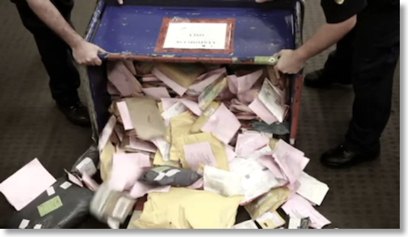
Australian import officers spill out a container full of confiscated packages of illegally-imported laser pointers.
Importing laser pointers greater than one milliwatt in intensity is prohibited in Australia without a permit.
“The sheer volume of these importations suggests that people do not understand the threat these items pose to safety, particularly to commercial aircraft,” said National Manager Cargo Operations, Jagtej Singh.
Customs and Border Protection officers are trained to detect prohibited and restricted items from the millions of items which arrive each week.
“If you try and import laser pointers without a permit, there’s a high possibility they’ll be found by Customs and Border Protection, seized, and you may even face fines of up to $275,000.”
Customs and Border Protection has produced a video clip outlining the risks being taken by people who inadvertently or deliberately breach the laws on laser pointers.
It can be viewed on the agency’s YouTube channel.
According to this video, “Customs officers screen all incoming mail imported into Australia, and items such as laser pointers WILL show up on X-ray.”
Media enquiries: Customs and Border Protection Media (02) 6275 6793
From Australia Customs and Border Protection
US: "Epidemic" of laser misuse in Myrtle Beach
Laser pointers are available for as little as $4 at many beachfront stores catering to tourists.
The president of a Myrtle Beach helicopter tour company says that his aircraft are hit “two, three times a week, sometimes more.” He says the increase makes him nervous for his pilots and clients. He says there is no education for laser pointer buyers about the potential hazard.
Click for video interview with Huffman Helicopter president Jeremy Bass.
From CarolinaLive. This is part of continuing stories at LaserPointerSafety.com about ongoing problems at Myrtle Beach.
Canada: RCMP purchases anti-laser glasses
From Vertical magazine
Click to read more...
US: Lasers used to tag UFOs?
Rose refers to YouTube clips where handheld lasers are pointed at moving dots of light in the sky.
Click to read more...
Canada: Health Canada again warns about hazards of pointers, handheld lasers
The agency states that battery-powered pointers and handhelds “manufactured, advertised, sold, imported or leased should be limited to … Class 3R” which is less than 5 mW visible output. It is unclear whether “should” is advisory or is a regulatory requirement.
The document focuses on eye, skin and fire hazards of lasers and does not discuss the problem of visual interference with pilots’ or drivers’ vision while operating vehicles.
From Newswire. The 2012 Health Canada press release is below (after the Read More… link). The July 2011 press release is here.
Click to read more...
South Africa: Laser pointer strapped to archer's head, to improve shooting accuracy
From the Council for Scientific and Industrial Research
UK: UPDATED - Selling illegal laser pens could net a 3-month sentence for UK man
33-year-old Techyun Hii ran Sky Laser Pointers from his home in Ribbleton, a suburb of Preston, Lancashire. In 2011, Lancashire Trading Standards officials found he had lasers that were up to 150 milliwatts, substantially over the U.K. limit of 1 milliwatts for laser pens sold to the public through an eBay store. Three packages were being sent to Greece, just before the Greek riots. He had been warned twice before about U.K. laws and his obligations.
In April 2012, investigators placed a test purchase which led to Hii’s arrest. He pleaded guilty to five counts of selling illegal goods, and will be sentenced July 4 2012.
From the Lancashire Evening Post
UPDATED November 25 2012: Hii was sentenced to a 180 day jail term, suspended for 18 months and was ordered to carry out 300 hours of unpaid work. The lasers sere destroyed by burning them in a hospital’s furnace. From the Lancashire Evening Post.
UPDATED March 22 2013: The case was the subject of a paper in the Proceedings of the 2013 International Laser Safety Conference, “Laser Product Assessment for Lancashire County Council Trading Standards Service” by John O’Hagan, Michael Higlett and Marina Khazova, pp. 181-188. A summary of the paper is here at LaserPointerSafety.com.
Italy: 10 incidents at Aviano NATO airbase in 18 months
From StrategyPage.com and Air Force Times
Canada: Laser statistics for 2010, 2011 and Q1 2012
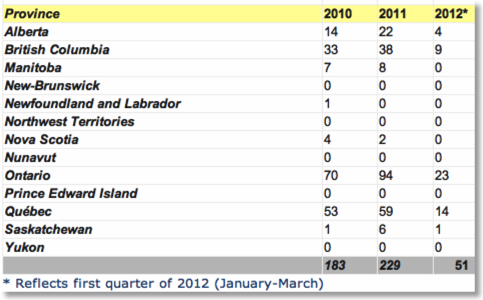
According to the Toronto Star, from January 1 to late May 2012 there have been 36 laser incidents at Pearson International and other Toronto-area airports, and 100 incidents nationwide. (This is probably based on their own analysis of the CADORS incident database since the Transport Canada chart above only went through the first quarter of 2012.)
WestJet has arranged for a Calgary-based ophthalmologist to examine pilots’ eyes after laser incidents. A spokesperson said “We want to have an individual identified in every major city so we can send that (pilot) right away to be tested.”
Canada lags other countries in aggressively prosecuting offenders, according to the chair of the flight safety division of the Air Canada Pilots Association: “The judicial system should apply the law to its maximum extent rather than soft-shoeing around the issue.” At the federal level, aiming a “directed bright light” at an aircraft is illegal under the Aeronautics Act. The maximum penalties are a prison term of five years and a fine of $100,000.
From the Toronto Star; chart courtesy Transport Canada
UPDATE, May 30 2012: At LaserPointerSafety.com’s request, Transport Canada analyzed first quarter incident statistics for the past three years. They found 29 incidents in Q1 2010, 27 incidents in Q1 2011, and 53 incidents in Q1 2012. (Note that they found two additional Q1 2012 incidents which were not included in the province-by-province breakdown above.) A Transport Canada spokesperson speculated that reasons for increased incidents in general may include increased awareness and reporting by pilots, and “copycat” actions by persons who would not think to aim a laser at aircraft until they hear news reports of incidents.
US: New Virginia law makes it a misdemeanor to knowingly aim at an aircraft
The bill amends the Commonwealth’s Acts of Assembly Chapter 5.1-22, covering interference with aircraft to also prohibit “projecting a point of light from a laser, laser gun sight, or any other device that simulates a laser at an aircraft…” The only exception is for persons authorized by the Federal Aviation Administration or by U.S. armed forces. Violation is a Class 1 misdemeanor, punishable by up to 12 months in jail and/or a fine of up to $2,500.
From the Virginia Legislative Information System and FairfaxTimes.com.
Scotland: 107 laser incidents in Glasgow in 2011
From the Scotsman
US: FAA to take harsher actions against persons aiming at aircraft
FAA has directed its staff not to seek warning notices or counseling, but to use “moderately high civil penalties” for inadvertent laser illuminations, and maximum penalties for deliberate violations.
In a video provided by FAA, LaHood said “I wonder how stupid people really can be” for not knowing that laser light could “cause great harm if the pilot is not able to continue to fly the plane safely…. people’s lives could be in jeopardy.” LaHood also said people should “understand that there are serious consequences to shining a laser at a pilot.”
The complete press release is below (click the “Read More...” link). This also has links to video and audio from LaHood and the acting FAA Administrator.
Click to read more...
UK: 15 laser incidents at East Midlands Airport in 10 months
Police warned of the hazards of endangering pilots and drivers, and noted that a violation could result in being sentenced to prison for life.
From This Is Derbyshire and the Loughborough Echo
Israel: Advanced anti-laser filter announced
It is not clear whether the filter is available at this time (May 2012). The company intends to incorporate it into glasses and night-vision goggles worn by pilots, to protect against flash blindness, meaning power densities from 100 µW/cm² up to 1000 µW/cm².
From Optics.org
Bahamas: Laser pointer is attached to a shark fin for publicity, science
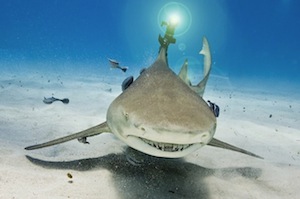
The late April 2012 undertaking was inspired by a recurring theme of Dr. Evil in the Austin Powers movies, who wanted a weapon of “frickin' sharks with frickin' laser beams attached to their frickin' heads.”
From Wired
US: Man builds a replica Star Trek phaser
This is not the first time such a project has been done. In 2007, Kip Kedersha (“Kipkay”) posted a YouTube video showing how he bought a surplus Playstation 3 laser diode for $45 and a Star Trek toy for $30, in order to make a laser-emitting phaser.
A Huffington Post story has the 2012 video, as well as links to earlier videos and detailed build instructions.
From Reddit via the Huffington Post
UK: CAA issues Safety Notice to pilots, after 2,300 laser attacks in 2011
Below are highlights from the document, which gives some background information and statistics, and then describes how affected crew should prepare for and react to a laser attack. (Emphasis in bold added by LaserPointerSafety.com.)
Click to read more...
UK: Eye test for pilots available from CAA website
The ALESA card is available in hard copy, and can also be downloaded from CAA’s website. If downloaded, the Amsler Grid on the first page should be printed so it is 10 x 10 cm.


Click for PDF version from CAA ALESA webpage
When staring at the dot in the center of the grid, if the lines appear distorted or there are blank or faded areas, there may be a problem. The person is encouraged to remove themselves from aviation-related duties such as flying or air traffic control, and to see an eye specialist.
The second page has a flowchart of exposure conditions leading either to a “1” meaning unlikely eye damage or a “2” meaning eye damage possibility. If the person scores a “2”, the flowchart suggests they see an eye specialist.
From PilotWeb and the CAA ALESA webpage. The CAA press release about ALESA is here.
South Africa: 181 laser incidents in 2+ years
On March 25 2012, an ATNS statement noted that air traffic control towers have been illuminated by laser light, in addition to airplanes and helicopters. ATNS said there have been at least two arrests, but thus far, no prosecutions.
South African aviation groups are joining together to publicize the hazards and penalties of aiming lasers at aircraft. They are also considering strengthening laws. According to the statement, laser ownership requires a permit, but illegal sales are taking place via imports and black market stores.
From The Star via Independent Online, News 24, and the Daily News. Thanks to Dr. Ian Powell for bringing this to our attention. The ATNS press release is after the link (click “Read More…”).
Click to read more...
US: Maryland "Laser Safety Act" passes House, goes to Senate
UPDATE, November 20 2012: The bill did not pass. According to Arora, it “passed the House of Delegates in March [2012] but ultimately failed to reach a vote in the state Senate during the final hours of the regular legislative session, when a budget showdown between the two chambers effectively killed scores of bills that were scheduled for votes.” It was reintroduced in November 2012, as discussed in this story.
AIRCRAFT LASER ATTACK BILL PASSES MARYLAND HOUSE, MOVES TO SENATE
Bill Would Punish Shining Laser Pointers at Pilots in Flight
ANNAPOLIS, Md. -- A measure aimed at curbing a dangerous trend targeting aircraft passed the Maryland House of Delegates Monday afternoon and now will head to the state Senate for approval.
The bill, the Laser Safety Act (HB 130), sponsored by Maryland State Delegate Sam Arora (D-Montgomery Co.), seeks stiffer penalties for people who shine laser pointers into aircraft cockpits, potentially blinding pilots in flight. The Act would carry a penalty of up to three years in prison and/or a fine of up to $2,500. Current law only permits for a $500 fine for “misuse of a laser pointer”.
Click to read more...
US & UK: UPDATED - Laser incident rate in U.K. more than twice the U.S. rate
- U.S. airports had 9,079,000 flights in 2011, with 3,591 laser incidents reported to the Federal Aviation Administration. This is a rate of one U.S. laser incident for every 2,528 flights. Said another way, this is 0.40 incidents per 1,000 flights.
- U.K. airports had 2,152,787 flights in 2011, with 1,909 laser incidents reported to the Civil Aviation Authority. This is a rate of one U.K. laser incident for every 1,128 flights. Said another way, this is 0.89 incidents per 1,000 flights.
The ratio of U.K. to U.S. rates is 2.24, meaning that the U.K. had more than twice the number of laser incidents than the U.S., when adjusted for the number of flights. (Important note: These figures do NOT mean that commercial aircraft are targeted at the rates indicated. Many laser incidents involve police helicopters. The analysis is simply meant to compare the two countries’ rates of laser misuse against aircraft of all types.)
It should also be noted that there could be many underlying factors affecting the precise numbers. For example, it is not known if the U.S. counts laser incidents in the same way as the U.K.
However, the figures do indicate that the U.K. rate of laser incidents appears to be significantly higher -- roughly twice the U.S. rate, based on the number of flights.
From an analysis by LaserPointerSafety.com, March 22 2012.
Updated May 27 2012 to correct a math error and make clear that it is the United Kingdom which has a higher rate of laser incidents (e.g., more incidents per 1000 flights). Our thanks to Brian Turner for pointing out this error.
Methodology: We define a “flight” as a takeoff plus a landing. US flight figures are from the Airline Activity “departures” statistic from the Department of Transportation’s Bureau of Transportation Statistics. It is assumed that each flight which departs also lands, so the data is accurate for “flights” as we have defined it. UK flight figures are from totaling column G, Total ATMs, from “Table 4, 1 Air Transport Movements 2011” found on the CAA UK Airport Statistics 2011 page. A UK “movement” is one takeoff plus one landing, so this is the same as our “flights” definition.
While the flight statistics compare only airline (US) and air transport (UK) flights, and do not include law enforcement flights, we believe this is a valid “apples to apples” comparison of how many more flights take place in the U.S. than in the U.K. A previous LaserPointerSafety.com analysis showed that law enforcement flights are less than 1% of the total flights from U.S. airports. Inclusion of law enforcement flight numbers would not significantly change the ratio of U.S.-to-U.K. flights.
.
US: Georgia bill would ban aiming at police and aircraft
The proposed bill would 1) establish the offense of unlawful pointing of a laser device at a law enforcement officer, and 2) prohibit aiming a laser pointer or projecting a laser on or at an aircraft or the flight path of an aircraft. The legislative history of the bill, including the full text of the Senate and House versions, is at the Georgia General Assembly website. We have also put the full text of the House version on the U.S. laws page here at LaserPointerSafety.com.
One interesting point is that the bill contains an exemption for “laser or laser pointer airspace uses that have been reviewed and approved by the Federal Aviation Administration.” This is a broader provision than the recently passed U.S. law, which only permits certain FAA-reviewed uses such as research and development.
In the view of LaserPointerSafety.com, the Georgia bill’s language is more flexible and still maintains safety, since they leave it up to the FAA to determine what outdoor laser uses are approved (technically, “non-objected”).
UK: 1,909 laser incidents in 2011; renewed calls for laser ban or restriction
In 2011, a law was introduced by MP Greg Mulholland (Leeds North West), to make it a criminal offense to shine a laser into an aircraft cockpit.
According the Civil Aviation Authority, there were 1,909 laser incidents in the U.K. in 2011, compared with three in 2008. [Note from LaserPointerSafety.com: The 2008 statistic is almost certainly incorrect. A previous LaserPointerSafety.com news item from BBC News reported 27 lasers were used against commercial aircraft in 2007, and there were 80 cases from January through September 2008.]
From the Bradford Telegraph and Argus
Worldwide: Laser weapons 10-20 years away from widespread deployment
One speaker noted “…we have had kinetic weapons for 500 years and laser weapons for 10-15 years…. The soldier wants a reliable, easy-to-handle, clear to understand system that has the reliability of a normal M16 rifle, or whatever, therefore the superiority is on the kinetic side.”
From Optics.org
US: Amateur astronomers illuminate International Space Station with spotlights and 1-watt laser
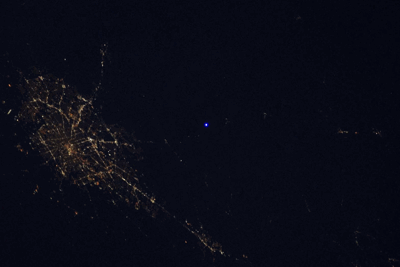
Two-frame animated GIF showing bright and dim light from the Lozano Observatory (center) near the city of San Antonio (left). North is to the right in this photo from the International Space Station, taken by astronaut Don Pettit. Click on photo for a larger version.
The spotlights were flashed at the ISS by holding plywood sheets in front of the lights every two seconds. This procedure can be seen in the video below.
The animated GIF above shows a bright blue light alternating with a dim light. The bright light is almost certainly from the spotlights. The bluish tint may be an artifact of oversaturating the camera’s sensor. Astronaut Don Pettit reported that the bright light appeared white, and the dim light appeared blue. He wrote “We could only see the laser when the white light was off and not all the time.” (E.g., the white spotlights overpowered the blue laser.) He added, “It was like there were tracking issues with the laser to keep it on target.”
The dim light in the animated GIF may be the laser only, or it may be light from the spotlights that wasn’t fully blocked by the plywood sheets. The astronomers will be working with Pettit, trying to pin down exactly how visible the laser light was.
General interest: Article discusses pros and cons of laser sights for weapons
Author John Wills notes that laser sights are not as effective beyond 20 feet, and they do not substitute for marksmanship techniques such as grip and stance.
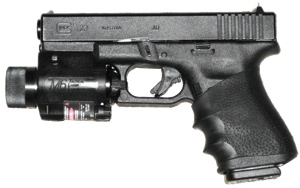
Glock Model 23 with M6 Tactical Laser Illuminator (xenon light plus red laser pointer < 5 mW).
Image from nukeit1 at Flickr, CC by 2.0 license.
Green laser sights are now available; they are more easily seen than an equivalent-power red laser. Infrared laser sights are made for use with night vision goggles. The beam cannot be seen by the naked eye, so a bad guy does not even know he is being targeted.
Wills concludes by saying “like any other tool there is a right way and a wrong way to use” lasers.
From Officer.com
US: Tampa police purchase anti-laser filters for night vision goggles
A person wearing NVGs is normally not at risk of retinal injuries, since direct laser light falls on the image intensifier device and not the eyes. (Depending on the NVG mounting style, it may be possible for direct laser light to enter from the side or from parts of the vision not covered by the NVG optics.) However, a serious concern is with laser light causing “blooming” of the night vision enhanced image, or even damaging the NVG sensor. To help prevent this, Night Flight Concepts developed “Laser Armor” Light Interference Filters.
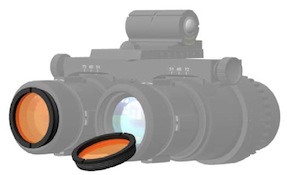
Company consultant Dr. Dudley Crosson says the screw-in filters “allow the goggles to function normally by reducing the blooming effect significantly.” A Laser Armor product sheet says the filters reduce blue (445-450 nm) intensity by 97%, and reduce green (532 nm) intensity by 99.5%.
From Aviation Today and a Night Flight Concepts press release
US: First comments on new U.S. law, from Western Pa. prosecutor
Hickton noted that the new law makes it easier to prosecute since malicious intent is no longer required. Instead, it must be proven that the defendant “knowingly” targeted an aircraft or its flight path with a laser pointer. The new law’s penalty is up to $250,000 fine and/or prison for up to five years.
A map from the FAA Allegheny Flight Standards District Office shows the location of 51 laser events between September 2009 and October 2011. Arrests were made in only two of these cases: “Hickton and other officials concede it can be difficult to pinpoint culprits.”
From 90.5 FM Essential Public Radio and the Pittsburgh Tribune-Review. A press release from Hickton’s office is below (click the Read More link). Edited Feb. 28 2012 at 3:15 PM EST to correct a statement from 90.5 FM.
UAE: Laser pointers seized, destroyed in Dubai
The newspaper report did not have specifics about the lasers’ numbers, power, color, etc.
From Emirat Alyoum. English-language reports from Emirates 24/7 and Bikya Masr.
UAE: Concern over lasers in Dubai and Abu Dhabi
DragonMart in Dubai claims to be “the largest trading centre for Chinese products outside mainland China,” with almost 4,000 shops. A Gulf News reporter found shops selling lasers under-the-counter for AED 40 to AED 80 ($11-$22). An internet search turned up lasers for sale in Dubai and Abu Dhabi around AED 500 ($136) that were described with terms such as “draw a line in the sky,” “extremely bright green,” and could cause “permanent eye damage”.
The article noted that United Arab Emirates officials have said that illegal use of lasers could lead to fines and jail time.
From GulfNews.com and DragonMart. We have found two articles about youths in Abu Dhabi being arrested after aiming lasers at a helicopter, in June 2010 and in October 2007. Video of the June 2010 incident, uploaded by the Abu Dhabi Police, is available on YouTube (click the photo to go to the YouTube page).
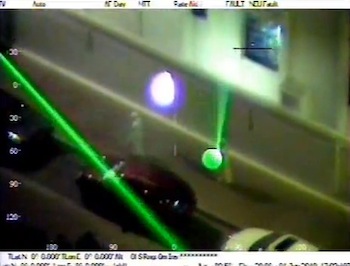
Two lasers, one from the left and one from the center, are briefly aimed at an Abu Dhabi Police helicopter, in a June 2010 video.
US: Obama signs bill making aiming laser pointers at aircraft a federal crime
Violation can result in a fine and/or imprisonment up to five years. The bill does provide a few exemptions for research and development, flight testing, the Department of Defense, and the Department of Homeland Security. The only exemption for ordinary citizens is when “using a laser emergency signaling device to send an emergency distress signal.”
The laser pointer misuse prohibition becomes part of the United States Code; specifically, Title 18, Chapter 2, new section 39A: “Aiming a laser pointer at an aircraft”. The text of the new law is here.
From AVStop News
US: First laser dazzler FDA-approved for non-military police

Range diagram from a PDF product brochure for the GLARE Enforcer laser dazzler
While the nominal ocular hazard zone (NOHD) at full power is 130 feet, the device includes a safe, low-power laser that measures the distance to a person or reflective object, and lowers the light level so it is safe at the detected distance. Military dazzlers do not have such a feature, relying instead on training soldiers not to aim the laser at persons closer than the hazard distance.
Laser journalist Jeff Hecht reported in a February 13 2012 article that there have been “some injuries” from military dazzlers, most of them minor. He also noted that ordinary citizens armed with laser pointers could be more of a hazard than police or military dazzlers. For example, lasers were used against police in Greece during riots in June 2011.
From New Scientist. The B.E. Meyers Electro-Optics GLARE Enforcer product page is here.
UK: 1,600+ laser pen incidents in first 9 months of 2011
From the Croydon Guardian
US: FAA clarifies "incidents" vs. "aircraft" laser illumination events
This is important because the FAA Laser Incident Database sometimes listed multiple reports from aircraft on a single spreadsheet row, if these were all in the same location at about the same time. Thus, it might appear that there was one “incident” which was reported by multiple aircraft. (This is how LaserPointerSafety.com interpreted an “incident” prior to February 15 2012.) However, FAA is now saying this was not their intent. While FAA may suspect that a single perpetrator was involved, they cannot be certain and thus to FAA this would be multiple incidents.
For example, in 2011, there were 12 spreadsheet rows that listed two or more aircraft as seeing the same laser. One row listed 5 aircraft, one row listed 3 aircraft, and ten rows listed 2 aircraft. Thus, there were 28-12 or 16 additional incidents according to FAA’s clarified definition.
The statistical analysis at LaserPointerSafety.com here and here reflects how FAA counts incidents.
.
US: Proposed Maryland law to increase penalties for shining lasers at aircraft
Co-sponsor Sam Arora said “We need this law … we’re talking about potential death.” The Maryland State Police testified in support of the bill at a February 7 2012 hearing that “the results [of a laser incident] could be deadly.” A WJZ TV news report said “Blinding a pilot at night is a good way to kill people.”
The bill only applies to laser pointers, defined under Maryland law (Title 3, Subtitle 8, Section 3-806) as any device that emits visible laser light. There are exemptions for lasers used for flight testing for the Federal Aviation Administration, the Department of Defense and the Department of Homeland Security.
The bill was introduced January 23 2012, and had its first reading on February 7. A companion Maryland Senate bill is expected to be introduced soon.
From Essex-Middle River Patch, CBS Baltimore WJZ, and the Maryland legislative information website. The full text of the bill is here; the Maryland definition of laser pointer is here.
Editorial note from LaserPointerSafety.com: A Maryland state police paramedic gave an erroneous demonstration to reporters purporting to show how a laser can be a hazard to aircraft. In a hangar, he aimed a red laser pointer at a helicopter windscreen only a few yards away. The resulting (grossly inaccurate) video shows a tiny red dot on the windscreen and in the aircraft. This is NOT what happens in a laser-aircraft incident. Instead, the light would be many inches across, even at low, helicopter-hovering altitudes of many hundreds of feet. The windscreen would further spread the light so that there would be a wide area of glare. In other words, the hazard is not a pinpoint that can go into one’s pupil, but a large “blob” of light that can cause temporary flashblindness, glare or distraction. This is an example of how laser hazards close up (within a few feet or yards) are very different from laser hazards to aircraft hundreds or thousands of feet away.
.
New Zealand: 100 incidents in 2011; pilots want Class 3 laser imports banned
There are currently no restrictions on the public’s ownership of lasers in New Zealand.
NZALPA’s technical director Stu Julian told TV ONE that if the laser incidents continue, they could cause a crash due to distracting a pilot when they have minimal reaction time.
According to the New Zealand Civil Aviation Authority, there were 100 laser pointer incidents in 2011, with 40 of those at the Auckland airport. A spokesperson for the Eagle police helicopter said the crew had lasers pointed at them “all the time. It happens fairly often and it’s a real risk to the crew.”
From MSN NZ, TVNZ, Scoop NZ, and the New Zealand Herald. The text of a Feb. 7 2012 press release from NZALPA is below (after the “Read More” link). Thanks to Mark Wardle of NZALPA for bringing this to our attention. The New Zealand Herald link has a list of selected New Zealand laser incidents. To find all aviation incidents from New Zealand reported at LaserPointerSafety.com, click here.
Click to read more...
US: Air Force spending $2,400 each, for 3,000+ laser protection glasses
[NOTE: The amounts above represent about $2,400 per pair of laser protection spectacles. More information about anti-laser glasses for pilots, including non-military versions protecting against one or two visible wavelengths for roughly $100-200, is here.]
From a Teledyne Technologies press release
US: 2011 total: 3,591 laser/aircraft incidents
Note: The FAA reports the 2011 total as 3,592. This is because the last entry in the FAA’s laser incident spreadsheet is on line 3,592. However, the spreadsheet headings are on line 1, so the actual number of 2011 incidents is 3,591 -- the number we use below.
What is an FAA-reported “laser incident”?: This is defined as an aircraft pilot seeing one or more laser beams during flight. A mid-2011 study by Rockwell Laser Industries of 6,903 incidents reported to the U.S. Federal Aviation Administration found that in 27% of incidents, beams entered the cockpit (passed through the windscreen). For example, in 2011, there were 3,591 incidents of which approximately 970 (27%) involved beams in the cockpit.
PowerPoint version available: A set of slides, presented to the SAE G10 aviation safety committee on Jan. 31, 2012, is available on the Files and Downloads page.
Yearly Comparison
Here are the number of incidents reported to FAA in recent years:- 2011: 3,591 incidents (9.8 per night)
- 2010: 2,836 incidents (7.7 per night)
- 2009: 1,527 incidents (4.2 per night)
- 2008: 949 incidents (2.6 per night)
- 2007: 639 incidents (1.8 per night)
- 2006: 384 incidents (1.1 per night)
- 2005: 283 incidents (0.78 per night)
- 2004: 46 incidents (0.13 per night) involving an unknown number of aircraft Note: FAA mandated that pilots report incidents using Advisory Circular 70-2, beginning January 19 2005. Before this date, pilot reporting was voluntary.
This is a total of approximately 10,201 incidents reported to FAA, from 2004 through the end of 2011.
Adverse Effects
In 55 of the 3,591 laser/aircraft incidents (1.5%), a pilot or aircraft occupant reported a temporary adverse visual effect such as flashblindness, afterimage, blurry vision, eye irritation and/or headache. None of these effects was classified as a recordable injury by FAA medical experts.In these 55 incidents…
- … there were 31 reports of pain or discomfort in the eyes or elsewhere (e.g., headache).
- … there were 31 reports of vision impairment such as afterimages (10) and blurry vision (7).
- … seven persons sought medical treatment after the laser exposure.
- … one person was grounded temporarily.
- … three flights were affected: in two cases, the pilot turned control over to the co-pilot; in one case the pilot felt he had to land immediately.
Rate of increase, by year
While laser incidents continue to increase, during 2011 the rate of increase slowed significantly.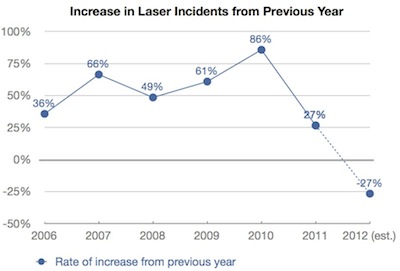
The rate of increase dropped 59% in 2011 (from 86.4% to 27%). If there is another 59% drop in 2012, (dashed line), then there would be a decrease in laser incidents for the first time, from 3,591 incidents in 2011 to 2,836 incidents projected for 2012.
Click to read more...
Worldwide: Concern over laser dazzling of satellites
“There are lasers used to hit satellites, it’s called dazzling, and it’s a show of force. There are a handful of countries that can do it. China dazzles U.S. and French satellites in low earth orbit not often, but regularly. What if a laser hits them, maybe lingers too long? A show of force can actually damage the satellite, knocks out some sensitive equipment. If that happens, and it’s from China, is that an act of war? What do you do? Political leaders have to be briefed on this. They have to make an effort to avoid escalation.”
From an interview in the Santa Barbara Independent conducted by Kevin Zambrano
South Africa: 70 incidents in 2011, including a go-around; no arrests
The majority of South African incidents occurred in Cape Town, with other reports at OR Tambo, Wonderboom in Pretoria, and Lanseria International. In an incident in Lanseria, “two pilots were blinded so badly that after landing they couldn’t see the man who signaled where to park the plane” according to News24.com.
There were no persons arrested during 2011 for aiming a laser at aircraft. Over all years, there have only been two incidents resulting in arrests (as of January 11 2012):
- Around January 7-8 2012, three persons were arrested for pointing green laser beams at helicopters using the Bloemfontein civil and Air Force airports.
- During the 2010 World Cup, a man temporarily blinded a helicopter pilot in Durban
A Civil Aviation Authority spokesperson said “It is a serious hazard to point laser lights at aircraft.” The maximum penalty for an offense is a “hefty fine and up to 30 years in jail.”
The general manager of the Air Line Pilots Association of South Africa said ALPA-SA members were reporting increasing numbers of incidents where “sudden and intense bursts of light [are] deliberately shone at aircraft…”
From The New Age and DefenceWeb
Commentary from LaserPointerSafety.com: The figure of 70 incidents reported to ATNS in 2011 is probably low. A May 5 2011 news story quoted ALPA-SA as saying they receive between 10 and 12 complaints from pilots every week. That would result in 520 to 624 laser illuminations per year. Also, the 70-incident figure may be a misunderstanding or misquote. A news story from March 2011 quotes ALPA-SA as saying there were 70 incidents in the 10 months from April 1 2010 through February 28 2011; see News24.com.
.
US: "The Straight Dope" answers the question "Should I be afraid of laser pointers?"
The answer first noted that laser weapons are large. An anti-missile laser required a Boeing 747, the Navy set fire to a boat with a destroyer-mounted laser, and a dazzler-type laser called the PHaSR is as portable “as a bag of cement.”
Then, Straight Dope purchased a 1 watt blue handheld laser (the same or similar to the Wicked Lasers Spyder III Arctic). They aimed it at room temperature pork chops and bacon. From one foot away, it took 27 seconds of continuous exposure before smoke appeared. Even with matches, it took 11 seconds to light a match from one foot away, and 15 seconds from 32 feet away.
The January 6 2012 column concluded that handheld laser ray guns are not practical: “…the likelihood that this laser would actually change somebody’s mind (other than via intimidation alone) is virtually nil…. no bad guy is going to sit still while you fry him.”
Story and photos are at the Straight Dope website. The column was also printed in the Washington City Paper.
UPDATE: In comments at the Washington City Paper, “dave b” noted that exposure to skin isn’t necessarily the important factor: “The key is to get the laser into someone’s eye.”
.
US: Los Angeles TV news report about increasing laser pointer incidents
KABC quoted the Glendora regional police helicopter tactical flight officer who was illuminated as saying “The laser could cause [eye] damage, and there’s a potential for the helicopter to crash.” The report said he and a pilot were recently trained by the FBI in how to handle a laser attack and how to track down a suspect.
Laser incidents are rising both nationwide and at local airport Los Angeles International (LAX), stated the report. It concluded by reminding the public that “any offense jeopardizes the safety of everyone.”

Click the screenshot above to view the video report from KABC
From KABC
UK: MP wants action to reduce laser pen attacks at Leeds Bradford Airport
Figures for 2010 showed about 100 laser pen attacks on flights taking off or landing at the Yeadon-based airport. Figures from January 2011 through October 2011 showed 80 such attacks, indicating that the 2011 total would be similar to 2010.
A CAA spokesperson said laser pen misuse in Britain was not letting up in 2011: “The people who are carrying out these attacks are either still ignorant of the dangers high-powered lasers present to the safe operation of an aircraft, or they simply do not care.”
Mulholland said “a blanket ban on laser pointers is not the way forward because of the effect it would have on legitimate users. Something does, however, need to be done to address this serious ongoing issue.”
From the Bradford Telegraph and Argus
